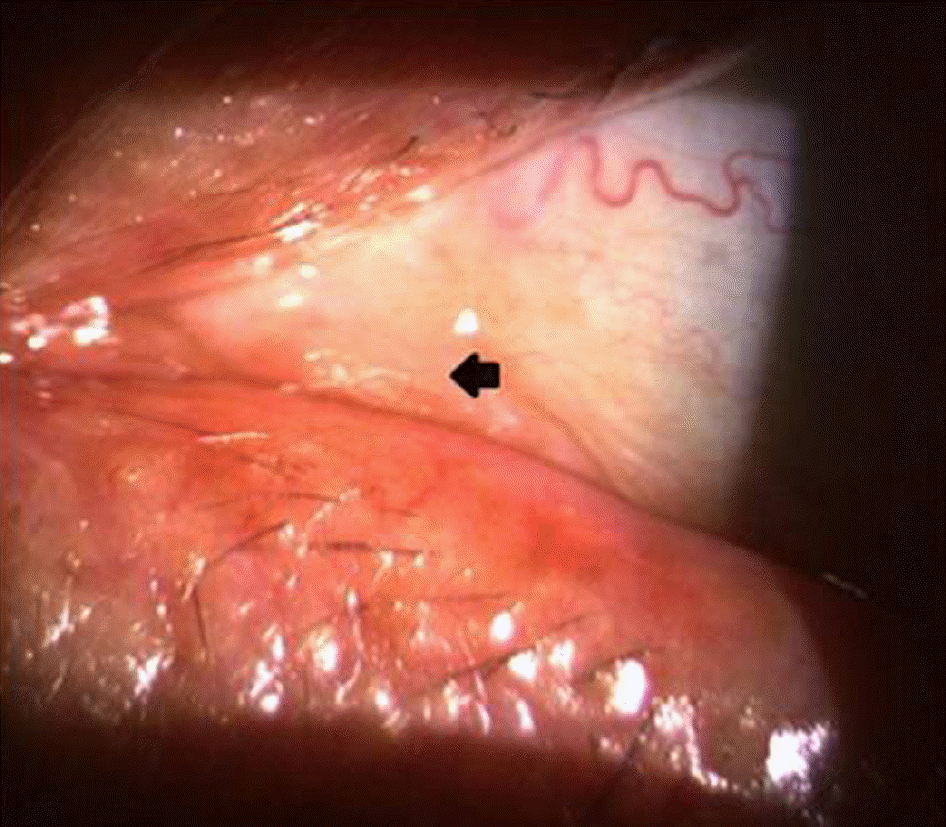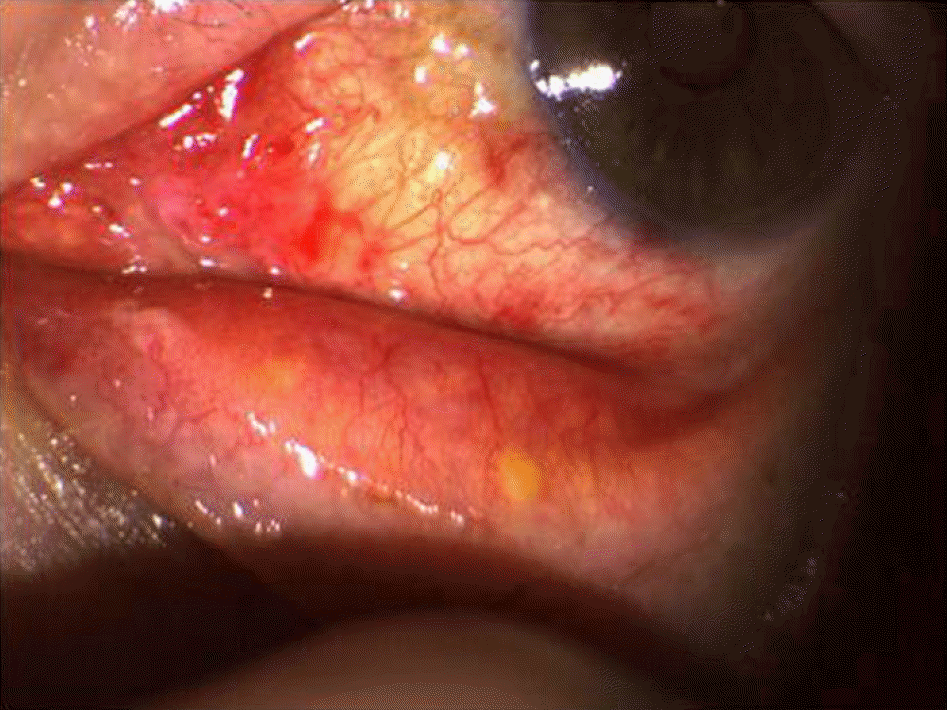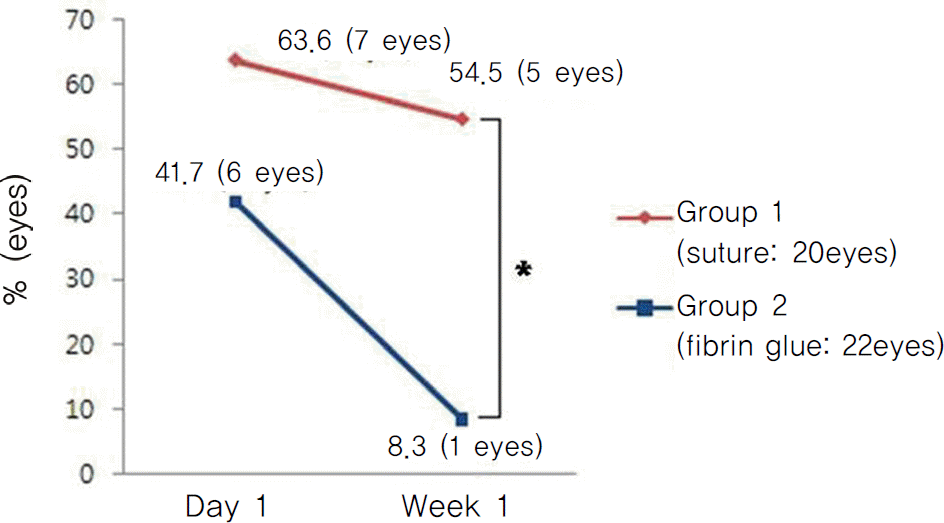Abstract
Purpose
To investigate the efficacy of fibrin glue used in conjunctival resection for conjunctivochalasis with epiphora
Methods
Twenty-three patients (42 eyes) with conjunctivochalasis without nasolacrimal duct obstruction underwent conjunctival resection using either absorbable sutures (11 patients, 20 eyes, Group 1) or fibrin glue (12 patients, 22 eyes, Group 2) to attach the conjunctiva to the sclera. Outcomes recorded were improvement of epiphora, postoperative discomfort, and operation time. Postoperative discomfort was analyzed only in one eye (right eye) in case that the both eyes were operated.
Results
Epiphora completely improved in 6 eyes (30%) in Group 1 and 8 eyes (36.4%) in Group 2, partially improved in 9 eyes (45%) and 8 eyes (36.4%), and did not improved in 5 eyes (25%) and 6 eyes (27.2%), respectively (p=1.000). On the first day postoperatively, postoperative eye discomfort developedin 7 eyes (63.6%) in Group 1 and 5 eyes (41.7%) in Group 2 (p=0.414). Throughout the following week, the discomfort lasted in 6 eyes (54.5%) in Group 1 and 1 eye (13.6%) in Group 2 (p=0.027). The mean operation time was 25.0 (±2.6) minutes in Group 1 and 12.0 (±2.4) minutes in Group 2 (p<0.001).
Go to : 
References
1. Meller D, Tseng SC. Conjunctivochalasis: literature review and possible pathophysiology. Surv Ophthalmol. 1998; 43:225–32.
3. Kheirkhah A, Casas V, Blanco G, et al. Amniotic membrane transplantation with fibrin glue for conjunctivochalasis. Am J Ophthalmol. 2007; 144:311–3.

4. Yamada KM, Olden K. Fibronectin-adhesive glycoproteins of cell surface and blood. Nature. 1978; 275:179–84.
5. Webster RG Jr, Slansky HH, Refojo MF, et al. The use of abdominal for the closure of corneal perforations: report of two cases. Arch Ophthalmol. 1968; 80:705–9.
6. Mandel MA. Closure of blepharoplasty incisions with autologous fibrin glue. Arch Ophthalmol. 1990; 108:842–4.

7. Alio JL, Mulet E, Sakla HF, Gobbi F. Efficacy of synthetic and abdominal bioadhesives in scleral tunnel phacoemulsification in eyes with high myopia. J Cataract Refract Surg. 1998; 24:983–8.
8. Uy HS, Reyes JM, Flores JD, Lim-Bon-Siong R. Comparison of fibrin glue and sutures for attaching conjunctival autografts after pterygium excision. Ophthalmology. 2005; 112:667–71.

9. Calson AN, Wilhelmus KR. Giant papillary conjunctivitis abdominal with cyanoacryl glue. Am J Ophthalmol. 1987; 104:437–8.
10. Francis IC, Chan DG, Kim P, et al. Case-controlled clinical and histopathological study of conjunctivochalasis. Br J Ophthalmol. 2005; 89:302–5.

11. Zhang XR, Cai Rx, Wang BH, et al. The analysis of abdominal of conjunctivochalasis. Zhonghua Yan Ke Za Zhi. 2004; 40:37–9.
12. Watanabe A, Yokoi N, Kinoshita S, et al. Clinicopathologic study of conjunctivochalasis. Cornea. 2004; 23:294–8.

13. Li DQ, Meller D, Liu Y, Tseng SC. Overexpression of MMP-1 and MMP-3 by cultured conjunctivochalasis fibroblasts. Invest Ophthalmol Vis Sci. 2000; 41:404–10.
14. Ko SM, Kim MK, Kim JC. The role of mast cell in hyperlaxity of conjunctiva. J Korean Ophthalmol Soc. 1997; 38:949–55.
15. Otaka I, Kyu N. A new surgical technique for management of conjunctivochalasis. Am J Ophthalmol. 2000; 129:385–7.

16. Oh SJ, Byon D. Treatment of conjunctivochalasis using bipolar cautery. J Korean Ophthalmol Soc. 1999; 40:707–11.
17. Kim HH, Shin DS, Lee KW. Effects of cauterization with abdominal in treatment of conjunctivochalasis: 4 Cases. J Korean Ophthalmol Soc. 2006; 47:843–6.
18. Lim HJ, Lee JK, Park DJ. Conjunctivochalasis surgery: amniotic membrane transplantation with fibrin glue. J Korean Ophthalmol Soc. 2008; 49:195–204.

19. Brodbaker E, Bahar I, Slomovic AR. Novel use of fibrin glue in the treatment of conjunctivochalasis. Cornea. 2008; 27:950–2.

20. Radosevich M, Goubran HA, Burnouf T. Fibrin sealant: abdominal rationale, production methods, properties, and current abdominal use. Vox Sang. 1997; 72:133–43.
Go to : 
 | Figure 1.An example of conjunctivochalasis. The lacrimal punctum is covered with lax conjunctiva (arrow). |
 | Figure 2.Photographs demonstrating the fibrin glue technique. (A) Component 1 (human fibrinogen, aprotinin) was instilled first after drying up the sclera surface, (B) which was followed by subsequent dropping of component 2 (thrombin, CaCl2). (C) Resected conjunctival edges were tightly approximated with forceps and pressure was given with cotton tip to fix the conjunctiva on the sclera. |
 | Figure 3.Photograph of a patient after conjunctival resection with fibrin glue technique. The conjunctiva is well attached without laxity by fibrin glue at post-operative day 1. |
 | Figure 4.Photographs of a patient with wound dehiscence. A wound gap is observed on the first day of conjunctival resection with fibrin glue. The eye recovered without any treatment 4 weeks later. |
 | Figure 5.Improvement of epiphora after surgery in 2 groups. Success rate of group 1 and group 2 is 75% and 72.8% respectively, and there is no significant difference in the success rate between the two groups(p=1.000). |




 PDF
PDF ePub
ePub Citation
Citation Print
Print




 XML Download
XML Download